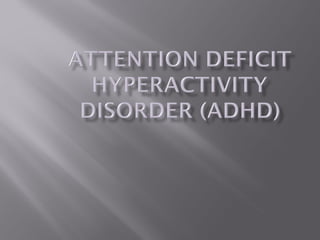Report
Share

Recommended
More Related Content
What's hot
What's hot (20)
IMNCI (Integrated Management of Neonatal and Childhood Illness)

IMNCI (Integrated Management of Neonatal and Childhood Illness)
Similar to ADHD topic in nurse
Similar to ADHD topic in nurse (20)
NIMH · Attention Deficit Hyperactivity Disorder (ADHD)

NIMH · Attention Deficit Hyperactivity Disorder (ADHD)
What is Attention Deficit Hyperactivity Disorder (ADHD.pptx

What is Attention Deficit Hyperactivity Disorder (ADHD.pptx
NIMH · Attention Deficit Hyperactivity Disorder (ADHD)

NIMH · Attention Deficit Hyperactivity Disorder (ADHD)
NIMH · Attention Deficit Hyperactivity Disorder (ADHD)

NIMH · Attention Deficit Hyperactivity Disorder (ADHD)
Recently uploaded
Recently uploaded (20)
Play hard learn harder: The Serious Business of Play

Play hard learn harder: The Serious Business of Play
Simple, Complex, and Compound Sentences Exercises.pdf

Simple, Complex, and Compound Sentences Exercises.pdf
Introduction to TechSoup’s Digital Marketing Services and Use Cases

Introduction to TechSoup’s Digital Marketing Services and Use Cases
21st_Century_Skills_Framework_Final_Presentation_2.pptx

21st_Century_Skills_Framework_Final_Presentation_2.pptx
Unit 3 Emotional Intelligence and Spiritual Intelligence.pdf

Unit 3 Emotional Intelligence and Spiritual Intelligence.pdf
dusjagr & nano talk on open tools for agriculture research and learning

dusjagr & nano talk on open tools for agriculture research and learning
PANDITA RAMABAI- Indian political thought GENDER.pptx

PANDITA RAMABAI- Indian political thought GENDER.pptx
ADHD topic in nurse
- 2. Characterized by inattentiveness, over activity, and impulsiveness Common disorder, especially in boys Essential feature of ADHD is a persistent pattern of inattention and/or hyperactivity and impulsivity more common than generally observed in children of the same age
- 3. ADHD may run in families, but it is not clear exactly what causes it. Whatever the cause may be, it seems to be set in motion early in life as the brain is developing. Imaging studies suggest that the brains of children with ADHD are different from those of other children.
- 4. Depression, lack of sleep, learning disabilities, and behavior problems may be confused with, or appear with, ADHD. Every child suspected of having ADHD should be carefully examined by a doctor to rule out possible other conditions or reasons for the behavior.
- 5. Most children with ADHD also have at least one other developmental or behavioral problem. They may also have a psychiatric problem, such as depression or bipolar disorder.
- 6. The symptoms of ADHD fall into three groups: Lack of attention (inattentiveness) Hyperactivity Impulsive behavior (impulsivity)
- 7. Fails to give close attention to details or makes careless mistakes in schoolwork Has difficulty keeping attention during tasks or play Does not seem to listen when spoken to directly Does not follow through on instructions and fails to finish schoolwork, chores, or duties in the workplace
- 8. Has difficulty organizing tasks and activities Avoids or dislikes tasks that require sustained mental effort (such as schoolwork) Often loses toys, assignments, pencils, books, or tools needed for tasks or activities Is easily distracted Is often forgetful in daily activities
- 9. Fidgets with hands or feet or squirms in seat Leaves seat when remaining seated is expected Runs about or climbs in inappropriate situations Has difficulty playing quietly Is often "on the go," acts as if "driven by a motor," talks excessively
- 10. Blurts out answers before questions have been completed Has difficulty awaiting turn Interrupts or intrudes on others (butts into conversations or games)
- 11. Predominantly hyperactive-impulsive- most symptoms (six or more) are in the hyperactivity-impulsivity categories. Fewer than six symptoms of inattention are present, although inattention may still be present to some degree.
- 12. Predominantly inattentive- the majority of symptoms (six or more) are in the inattention category and fewer than six symptoms of hyperactivity-impulsivity are present, although hyperactivity-impulsivity may still be present to some degree.
- 13. Combined hyperactive-impulsive and inattentiveSix or more symptoms of inattention and six or more symptoms of hyperactivity- impulsivity are present. -Most children with ADHD have the combined type.
- 14. Set specific, appropriate target goals to guide therapy. Start medication and behavior therapy. Follow-up regularly with the doctor to check on goals, results, and any side effects of medications. During these check-ups, information should be gathered from parents, teachers, and the child.
- 15. These drugs include: Amphetamine-dextroamphetamine (Adderall) Dexmethylphenidate (Focalin) Dextroamphetamine (Dexedrine, Dextrostat) Lisdexamfetamine (Vyvanse) Methylphenidate (Ritalin, Concerta, Metadate, Daytrana) A nonstimulant drug called atomoxetine (Strattera) may work as well as stimulants, and may be less likely to be misused.
- 16. Talk therapy for both the child and family can help everyone understand and gain control of the stressful feelings related to ADHD. Parents should use a system of rewards and consequences to help guide their child's behavior. It is important to learn to handle disruptive behaviors. Support groups can help you connect with others who have similar problems.
- 17. Although there is no proven way to prevent ADHD, early identification and treatment can prevent many of the problems associated with ADHD.